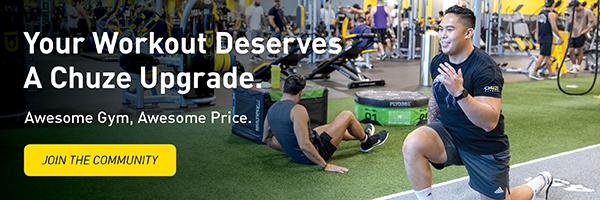Belt Squats: Step-by-Step Instructions, Benefits Guide and Video
In the gym, training comes second only to safety. After all, if you get injured, you may have to sit around for weeks, watching all your progress fall apart.
So when you find an exercise that combined safety with muscle-building results, it’s worth incorporating into your workout routine.
The exercise we’re talking about? The belt squats.
Belt squats give you all the benefits of a barbell squat while taking the strain off your back. Plus, they are a very effective workout and in this guide we explain how and why you should try them.
Belt Squats, Explained
Think of the belt squat as a weighted variation of the traditional squat. The extra weight, attached to you by a belt, increases the difficulty of the workout, thereby maximizing your gains. If you want to improve lower body strength And balance, few exercises are as reliable as the belt squat.
Like squats, belt squats target several major muscle groups, including:
- Glutes
- Hamstrings
- Quads
- Calves
- Hip flexors
- Core muscles
However, unlike your traditional do-anywhere squats, belt squats require equipment. You’ll need a belt and weights (or a squat machine with a belt) to perform this workout correctly.
The many benefits of belt squats
That said, the extra setup and effort is worth it. Belt squats are a phenomenal exercise for all athletes and gym goers, whether you are an amateur or a fitness fanatic.
More specifically, belt squats are known for:
- Building Lower Body Strength – When you do belt squats, you quickly build muscle in your legs. This muscle growth can help you perform better during other exercises at the gym, as well as in sports and activities that emphasize your lower body, such as running, hockey, and swimming. As an added bonus, belt squats strengthen the ankle and knee joints, keeping these injury-prone areas stress-free.
- Promoting stability – All squat exercises work your adductors. These small muscles on your inner thigh contribute to your stability and mobility, helping you maintain balance when walking or standing.
- Protect the spine – Belt squats are particularly beneficial for people with mobility issues or chronic back pain. Unlike the barbell squat, which places all the weight on your back, belt squats load the weight onto your hips. This placement reduces the risk of spinal injuries.
- Growing flexibility – When performed correctly, belt squats can help keep your muscles flexible. Each time you perform the full range of motion, you stretch your legs and hips, improving your overall flexibility.
How to do belt squats?
There are two ways to perform belt squats. As long as you have the right equipment in your gym, you can do whatever you prefer.
The first method involves a specialized belt from which you can hang a weight. The second option uses a squat machine with a built-in belt and pulley weight system.
Regardless of which method you choose, you will follow the same steps to perform a set of belt squats:
- Step 1: Select your weight – First, you will decide how much you want to lift. We suggest starting with lighter plates before progressing.
- Step 2: Put on the belt – Next, you will attach the belt around your body, tying it securely around your waist.
- Step 3: Lower yourself into a squat – With the weighted belt ready, look ahead, straighten your torso and bend your knees. Continue lowering until your thighs are at least parallel to the floor.
- Step 4: Straighten your legs – To return to standing, dig your heels into the ground and straighten your legs. Repeat as needed.
Useful tips for beginners
If you’re new to belt squats, you may find the exercise intimidating. These tips should help you conquer your fears:
- Train with lighter weights – Although it may seem easy, do your first belt squats with 5 or 10 pounds. It is more important to learn proper form than to lift a heavy load. Once you are comfortable, you can increase the weight.
- Start with fewer repetitions – Belt squats are relatively intense, so take it easy. Series of 5 to 10 repetitions are enough at the beginning.
- Crouch low to the ground – You will see the biggest gains when you squat as deeply as possible. If you can, drop your seat low to the floor, bringing your hips and thighs together.
Common mistakes to avoid
No matter your experience level, you can accidentally develop bad habits when doing belt squats. Don’t worry, it happens.
The important thing is to notice and correct these habits. Here are some errors to watch out for.
Incorrect positioning of the belt
Beginners will sometimes wear the belt too high or too low. Unfortunately, poor placement can lead to back injuries, negating one of the most important benefits of belt squats.
Before you begin, make sure the bottom of the belt sits comfortably on the top of your hips. This positioning distributes the weight evenly and ensures your safety.
Lean forward
Normally, when you bend at the knees, perhaps to pick something up or tie your shoes, you bend at the hips. However, when doing belt squats, it is crucial to keep your torso straight.
For optimal results, maintain a vertical torso and engaged core throughout the squat.
Rushing into exercise
As always, slow and steady wins the race. Although the extra weight may tempt you to perform your set of belt squats, try to take your time and exaggerate the up and down movements of the squat.
Moving with control will reduce your risk of injury and allow you to reap the maximum benefits of your workout.
Chuze Fitness: The Ultimate Environment for Belt Squats
If you’ve never tried belt squats, now is the perfect time to add them to your routine. The belt squat can help you quickly build lower body strength and improve your balance and posture.
Since belt squats require specialized equipment, you’ll need to go to the right facility. Luckily, Chuze Fitness has all the tools you need to perform proper waist squats, as well as any other exercises you want to tackle.
Start your membership today!
Sources:
Cleveland Clinic. Here’s the Right Way to Do a Squat. https://health.clevelandclinic.org/proper-squat-form
National Center for Biotechnology Information. Anatomy, bony pelvis and lower limb: adductor major muscle of the thigh. https://www.ncbi.nlm.nih.gov/books/NBK534842/
 Reviewed by:
Reviewed by:
Ani is the Vice President of Fitness at Chuze Fitness and oversees the group fitness and team training departments. She has had a career spanning over 25 years in club management, personal training, group exercise and instructor training. Ani lives with her husband and son in San Diego, California and loves hot yoga, snowboarding, and all things wellness.










